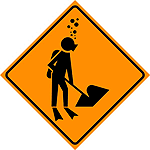|
| |

|
|
| < Prev. month |
Next month > |

|
This page under construction.
Here are some of the topics that will be covered in this chapter. More text and images will eventually be added to this section. Thank you for your patience.
|
- As northwest winds and wind-generated waves subside, sand on continues to build up exposed beaches, burying some intertidal rocks and the algae and attached animals that colonized these exposed surfaces during winter and spring. This process will continue until the first winter storms (typically in late October).
- Intertidal algae begin to reach maximum lushness. Some annual species, such as Porphyra perforata, are only found at this time of year.
- Many seaweeds begin releasing spores. For example, rockweed (Fucus spp.) reaches maximum densities and releases gametes at low tide, when the water is still.
- Sea hares gather in large numbers to mate and lay eggs. Their larvae drift for about a month before settling on Plocamium red algae. By that time, the adults are likely to have died off.
- Giant green anemones and their smaller relatives, the proliferating anemones, broadcast spawn.
- As upwelling becomes less frequent, larvae that may have been drifting offshore for months are carried toward shore, causing pulses of barnacles, snails, mussels, limpets, hermit crabs, and many different types of worms to settle on rocks and in tide pools.

|
|
